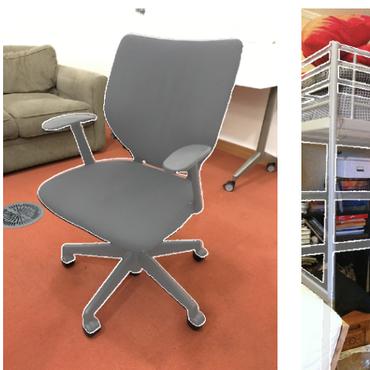Search Results for author: Xibin Zhao
Found 14 papers, 1 papers with code
Revisiting Graph-Based Fraud Detection in Sight of Heterophily and Spectrum
no code implementations • 11 Dec 2023 • Fan Xu, Nan Wang, Hao Wu, Xuezhi Wen, Xibin Zhao, Hai Wan
This detector includes a hybrid filtering module and a local environmental constraint module, the two modules are utilized to solve heterophily and label utilization problem respectively.
Hypergraph-Guided Disentangled Spectrum Transformer Networks for Near-Infrared Facial Expression Recognition
no code implementations • 10 Dec 2023 • Bingjun Luo, Haowen Wang, Jinpeng Wang, Junjie Zhu, Xibin Zhao, Yue Gao
With the strong robusticity on illumination variations, near-infrared (NIR) can be an effective and essential complement to visible (VIS) facial expression recognition in low lighting or complete darkness conditions.
 Facial Expression Recognition
Facial Expression Recognition
 Facial Expression Recognition (FER)
Facial Expression Recognition (FER)
Multi-Energy Guided Image Translation with Stochastic Differential Equations for Near-Infrared Facial Expression Recognition
no code implementations • 10 Dec 2023 • Bingjun Luo, Zewen Wang, Jinpeng Wang, Junjie Zhu, Xibin Zhao, Yue Gao
Illumination variation has been a long-term challenge in real-world facial expression recognition(FER).
 Facial Expression Recognition
Facial Expression Recognition
 Facial Expression Recognition (FER)
+1
Facial Expression Recognition (FER)
+1
Few-shot Message-Enhanced Contrastive Learning for Graph Anomaly Detection
no code implementations • 17 Nov 2023 • Fan Xu, Nan Wang, Xuezhi Wen, Meiqi Gao, Chaoqun Guo, Xibin Zhao
Graph anomaly detection plays a crucial role in identifying exceptional instances in graph data that deviate significantly from the majority.
Exploring Global and Local Information for Anomaly Detection with Normal Samples
no code implementations • 3 Jun 2023 • Fan Xu, Nan Wang, Xibin Zhao
To address such problem, we propose an anomaly detection method GALDetector which is combined of global and local information based on observed normal samples.
TBDetector:Transformer-Based Detector for Advanced Persistent Threats with Provenance Graph
no code implementations • 6 Apr 2023 • Nan Wang, Xuezhi Wen, Dalin Zhang, Xibin Zhao, Jiahui Ma, Mengxia Luo, Sen Nie, Shi Wu, Jiqiang Liu
APT detection is difficult to detect due to the long-term latency, covert and slow multistage attack patterns of Advanced Persistent Threat (APT).
xASTNN: Improved Code Representations for Industrial Practice
no code implementations • 13 Mar 2023 • Zhiwei Xu, Min Zhou, Xibin Zhao, Yang Chen, Xi Cheng, Hongyu Zhang
The proposed xASTNN has three advantages.
Grow and Merge: A Unified Framework for Continuous Categories Discovery
no code implementations • 9 Oct 2022 • Xinwei Zhang, Jianwen Jiang, Yutong Feng, Zhi-Fan Wu, Xibin Zhao, Hai Wan, Mingqian Tang, Rong Jin, Yue Gao
Although a number of studies are devoted to novel category discovery, most of them assume a static setting where both labeled and unlabeled data are given at once for finding new categories.
View-Guided Point Cloud Completion
no code implementations • CVPR 2021 • Xuancheng Zhang, Yutong Feng, Siqi Li, Changqing Zou, Hai Wan, Xibin Zhao, Yandong Guo, Yue Gao
This paper presents a view-guided solution for the task of point cloud completion.
 Ranked #3 on
Point Cloud Completion
on ShapeNet-ViPC
Ranked #3 on
Point Cloud Completion
on ShapeNet-ViPC
Dual Channel Hypergraph Collaborative Filtering
no code implementations • SIGKDD 2020 • Shuyi Ji, Yifan Feng, Rongrong Ji, Xibin Zhao, Wanwan Tang, Yue Gao.
Second, the hypergraph structure is employed for modeling users and items with explicit hybrid high-order correlations.
Attention-based Multi-modal Fusion Network for Semantic Scene Completion
no code implementations • 31 Mar 2020 • Siqi Li, Changqing Zou, Yipeng Li, Xibin Zhao, Yue Gao
This paper presents an end-to-end 3D convolutional network named attention-based multi-modal fusion network (AMFNet) for the semantic scene completion (SSC) task of inferring the occupancy and semantic labels of a volumetric 3D scene from single-view RGB-D images.
 Ranked #13 on
3D Semantic Scene Completion
on NYUv2
Ranked #13 on
3D Semantic Scene Completion
on NYUv2
PVRNet: Point-View Relation Neural Network for 3D Shape Recognition
no code implementations • 2 Dec 2018 • Haoxuan You, Yifan Feng, Xibin Zhao, Changqing Zou, Rongrong Ji, Yue Gao
More specifically, based on the relation score module, the point-single-view fusion feature is first extracted by fusing the point cloud feature and each single view feature with point-singe-view relation, then the point-multi-view fusion feature is extracted by fusing the point cloud feature and the features of different number of views with point-multi-view relation.
MeshNet: Mesh Neural Network for 3D Shape Representation
2 code implementations • 28 Nov 2018 • Yutong Feng, Yifan Feng, Haoxuan You, Xibin Zhao, Yue Gao
However, there is little effort on using mesh data in recent years, due to the complexity and irregularity of mesh data.
GVCNN: Group-View Convolutional Neural Networks for 3D Shape Recognition
no code implementations • CVPR 2018 • Yifan Feng, Zizhao Zhang, Xibin Zhao, Rongrong Ji, Yue Gao
The proposed GVCNN framework is composed of a hierarchical view-group-shape architecture, i. e., from the view level, the group level and the shape level, which are organized using a grouping strategy.








